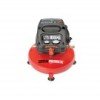Harbor Freight Tools 95275 User Manual - Page 13
Troubleshooting
 |
View all Harbor Freight Tools 95275 manuals
Add to My Manuals
Save this manual to your list of manuals |
Page 13 highlights
Troubleshooting Problem Possible Causes Likely Solutions Compressor does not start or restart 1. Tank(s) already pressurized. 1. No problem. Compressor will start when needed. 2. Power cord not plugged in properly. 2. Check that cord is plugged in securely. 3. No power at outlet. 3. Reset circuit breaker, or have outlet serviced by a qualified technician. 4. Thermal overload switch tripped. 4. Turn off Compressor and wait for it to cool down. Press reset button. Resume operation. 5. Building power supply circuit tripped or blown fuse. 5. Reset circuit or replace fuse. Check for low voltage conditions. It may be necessary to disconnect other electrical appliances from the circuit or move the compressor to its own circuit. 6. Cord wire size is too small or cord is too long to properly power compressor. 6. Use larger diameter or shorter extension cord or eliminate extension cord. See Recommended Wire Gauge for Extension Cords in Safety section. 7. Compressor needs service. 7. Have unit inspected by a qualified technician. Compressor not building enough air pressure 1. Air filters need cleaning/replacing. 2. Check Valve needs service. 3. Compressor not large enough for job. 4. Loose fittings. 5. Hose or hose connections too narrow. 6. High altitude reducing air output. 1. Check inlet and outlet filters. Clean and/or replace as needed. 2. Have technician clean or replace, as needed. 3. Check if accessory CFM is met by Compressor. If Compressor cannot supply enough air flow (CFM), you need a larger Compressor. 4. Reduce air pressure, then check all fittings with a soap solution for air leaks and tighten as needed. Do not overtighten. 5. Replace with wider hose and/or hose connections. 6. Higher altitudes require compressors with greater output. Overheating 1. Unusually dusty environment. 2. Cord is too small of a gauge or too long to handle compressor. 3. Unit not on level surface. 1. Move unit to cleaner environment. 2. Increase cord size or use shorter length extension cord, or eliminate extension cord. See Recommended Wire Gauge for Extension Cords in Safety section. 3. Reposition unit on a level surface. Compressor starts and stops excessively 1. Loose fittings. 2. Compressor not large enough for job. 1. Reduce air pressure, then check all fittings with a soap solution for air leaks and tighten as needed. Do not overtighten. 2. Check if accessory CFM is met by Compressor. If Compressor doesn't reach accessory CFM, you need a larger Compressor. Excessive noise Loose fittings. Reduce air pressure, then check all fittings with a soap solution for air leaks and tighten as needed. Do not overtighten. Moisture in discharge air Too much moisture in air. Install inline air filter/dryer, and/or relocate to less humid environment. Safety Valve "pops" Safety valve needs service. Pull on test ring of safety valve. If it still pops, replace. Air leaks from pump or fittings Loose fittings. Reduce air pressure, then check all fittings with a soap solution for air leaks and tighten as needed. Do not overtighten. Air leaks from tank Defective or rusted tank. Have tank replaced by a qualified technician. Drain moisture from tank daily to prevent future corrosion. A Follow all safety precautions whenever diagnosing or servicing the compressor. Disconnect power supply before service. 2 Item 95275 For technical questions, please call 1-888-866-5797. Page 13















